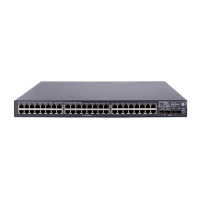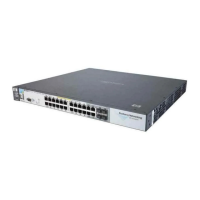Static Virtual LANs (VLANs)
Static VLAN Operation
overlap in this way, VLAN “tags” are used in the individual packets to distin-
guish between traffic from different VLANs. A VLAN tag includes the particu-
lar VLAN I.D. (VID) of the VLAN on which the packet was generated.
ProCurve
Switch
802.1Q-Compliant
Server
Figure 2-3. Example of Overlapping VLANs Using the Same Server
Similarly, using 802.1Q-compliant switches, you can connect multiple VLANs
through a single switch-to-switch link.
Red Server
ProCurve
Switch
Blue Server
ProCurve
Switch
Red
VLAN
Red
VLAN
Blue
VLAN
Blue
VLAN
Red
VLAN
The same link carries Red
VLAN and Blue VLAN traffic.
Figure 2-4. Example of Connecting Multiple VLANs Through the Same Link
Introducing Tagged VLAN Technology into Networks Running Legacy
(Untagged) VLANs. You can introduce 802.1Q-compliant devices into net-
works that have built untagged VLANs based on earlier VLAN technology. The
fundamental rule is that legacy/untagged VLANs require a separate link for
each VLAN, while 802.1Q, or tagged VLANs can combine several VLANs in one
link. This means that on the 802.1Q-compliant device, separate ports (config-
ured as untagged) must be used to connect separate VLANs to non-802.1Q
devices.
2-10

